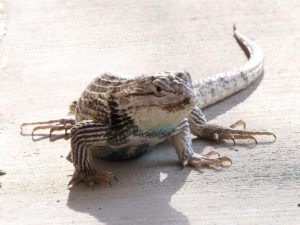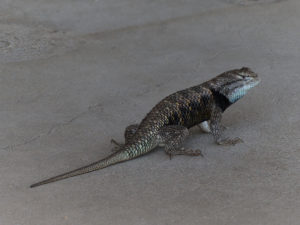It seems like nearly every trip to the California deserts lately, I encounter Desert Spiny Lizards (Sceloporus magister). They are resident in desert habitats across the American Southwest and northern Mexico and can be anywhere in elevation from well below sea level to about 5000 feet.
Desert Spiny Lizards Appearance
Unlike many desert species which use extensive camouflage to hide from predators, male Desert Spiny Lizards are very colorful below and have muted color on their flanks, with a vivid blue throat and belly, blue flanks flecked with yellow/gold, and a black triangular patch in front of each shoulder. Females and juveniles are more patterned with tan, gray, and dark spotting all over. Spiny Lizards can regulate their body temperature by changing their color from darker in the winter to absorb heat from the sun to paler in the summer to reflect the sun for cooling. Fully grown males can measure over 5.5 inches from snout to vent, with a tail nearly as long. As you can see from the photos, nearly all of their scales have needle-like tips, giving the species its name.
Diet
Desert Spiny Lizards are omnivores. Their main diet is insects like ants, beetles, and caterpillars, spiders, centipedes, and even small lizards. They also eat various plants and seeds, which are their main source of water. While we don’t encourage this, people have kept Spiny Lizards as pets, feeding them vegetables and fruits such as grapes.
Behavior
As with most reptiles, Desert Spiny Lizards are cold blooded, so their body temperature is lower at night and warmer once they get into the sun. Therefore, they tend to sun themselves on hard surfaces to warm up in the morning and then seek shade later in the day. Depending on their location, they tend to hibernate from the late fall until the early spring.
Viewing
The photos in this article were taken with an 800mm lens, so if you want to see Desert Spiny Lizards up close, you may want to visit our binocular section to be prepared.


